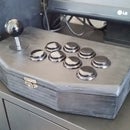Introduction: Wooden Raspberry Pi Box With Fan
Bought a Raspberry Pi 3 to use as a media center in my living room and I couldn't find any enclosure for it that I'd like so I decided to build one myself. Since it was gonna be on all the time I opted to have a fan built in. Also I opted for a big 70x70 mm 12v CPU fan since I had one lying about and it makes almost no sound when running on 5v. Note that CPU fans work from 3.3v to 12v.
Also note that I'm using a 5v 2.5A charger and nothing else is connected to the Pi but the Pi itself.
I use Yatse app on my android phone as remote control over WiFi and OS I'm using on the Pi is OpenELEC.
Step 1:
Tools and materials used:
- 7mm plywood
- 70x70x15mm brushless CPU fan
- 4x 5mm hex M3 spacers with screws
- 5x 10mm wood screws
- heatshrink tube
- water based wood paint
- jigsaw
- drill
- pliers
- sandpaper
- screwdriver
- marking tool
- scalpel
- wood and metal file
- paintbrush
Step 2:
Firstly I marked the width and length I wanted my enclosure to be and cut out a square bit for the bottom (9x10 cm).
Step 3:
Next I marked where the holes for the hex spacers are gonna be in and made pilot holes before screwing them in place. You can't see it clearly in the picture but the side with USB adapters is lined up with the face while the side with HDMI is 7mm away from the edge (the thickness of the plywood).
Step 4:
Put the Pi into place so it wouldn't move and marked where to cut out the holes. Decided the the height would be 45mm.
Step 5:
Holes were cut out with the jigsaw and filed to size. Then I cut two more pieces of plywood for the sides. Notice there is a lot of room on the side with the GPIO, this is to allow the wire from the fan to fit without any issues or worries.
Step 6:
Repeated the process for the last side panel. Audio jack hole was drilled through and then sanded. I also removed one layer of plywood there because audio jack is sticking out a bit compared to the other jacks on that side.
The side panels got glued together with wood glue.
Step 7:
Measured and cut the hole for the fan. The little notch on the side is to fit the wires through.
Step 8:
Fan screwed into place, signal wire (white) cut off and red and black wires left. Since my Dupont single pins didn't arrive yet I used the existing ones that were on the fan and piece of heat shrink to make them into small clamps. I highly recommend not doing it this way and buying the proper pin-to-pin connectors.
Other thing I did was that I cut off a layer of plywood where the USB and RJ45 are so that my fan would lie flat with the top. Wouldn't have to do that if I opted for the sides to be 50 mm high instead of 45 mm.
Step 9:
Then I cut the top and air holes in it. Sanded it down, made countersinks for the screws and enclosed the thing.
Step 10:
I marked there the holes in the bottom go, drilled pilot holes for the screws and made countersinks before assembly.
Then came quite a lot of sanding to get everything nice and flat.
Step 11:
Last I connected the fan to the Pi. As seen on the GPIO pinout, red is connected to 5v (pin 4) and black to ground (pin 6).
Assembled the enclosure and checked if everything works before painting.
Step 12:
Everything got sanded down again and painted.
Hope you enjoy the box and happy building!

Participated in the
Circuits Contest 2016







![Tim's Mechanical Spider Leg [LU9685-20CU]](https://content.instructables.com/FFB/5R4I/LVKZ6G6R/FFB5R4ILVKZ6G6R.png?auto=webp&crop=1.2%3A1&frame=1&width=306)





